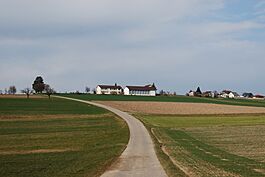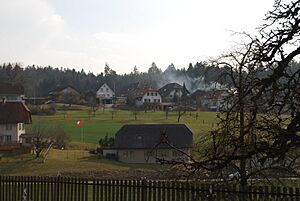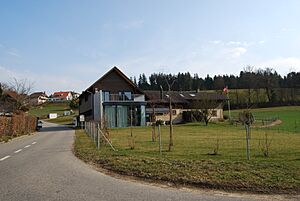Obersteckholz facts for kids
Quick facts for kids
Obersteckholz
|
||
|---|---|---|
 |
||
|
||
| Country | Switzerland | |
| Canton | Bern | |
| District | Oberaargau | |
| Area | ||
| • Total | 3.9 km2 (1.5 sq mi) | |
| Elevation | 525 m (1,722 ft) | |
| Population
(November 2019)
|
||
| • Total | 422 | |
| • Density | 108.2/km2 (280/sq mi) | |
| Postal code |
4924
|
|
| Surrounded by | Busswil bei Melchnau, Langenthal, Lotzwil, Untersteckholz | |
Obersteckholz was a small town, or municipality, in Switzerland. It was located in the Bern canton, which is like a state or region, within the Oberaargau district. On January 1, 2021, Obersteckholz joined with a larger town called Langenthal. So now, it's part of Langenthal.
Contents
History of Obersteckholz
Obersteckholz was first mentioned in old records in the year 1255. Back then, its name was Stechcholz.
Early Ownership and Changes
Long ago, Obersteckholz belonged to a noble family called the Barons of Langenstein. In 1194, one of these barons started a special church called St. Urban's Abbey. He gave Obersteckholz to the Abbey as a gift.
The village was part of the Abbey's area until 1406. Then, it became part of Bern's territory, specifically a district called Wangen.
Becoming Independent
In 1798, the French army invaded Switzerland. After this, Obersteckholz became part of the Langenthal district under a new government called the Helvetic Republic.
When that government ended in 1803, it moved to the Aarwangen District. Finally, in 1831, Obersteckholz became its own independent municipality.
Schools and Jobs
For many years, Obersteckholz and a nearby village, Untersteckholz, shared the same school district. This was true until 1790 and again after 1975.
In the 1700s and 1800s, people in Obersteckholz started making things at home. They wove linen and braided straw to earn extra money. This helped their farming economy. Today, there are still some small businesses in the village. However, most adults (about 71%) travel to other towns for work.
Geography of Obersteckholz
Obersteckholz covered an area of about 3.9 square kilometers (1.5 square miles). A large part of this land, about 66.7%, was used for farming. This means people grew crops or raised animals there.
Land Use and Forests
About 27.9% of the area was covered by forests. The remaining 5.6% was built-up areas, like buildings and roads.
Most of the built-up land (4.1%) was for houses and other buildings. Roads and transportation took up about 1.3%. All the forested land was covered with thick, heavy forests.
Farming and Villages
On the farmland, 44.4% was used for growing crops. Another 17.9% was used as pastures for animals. A small part, 4.4%, had orchards or vineyards.
The former municipality included the main village of Obersteckholz. It also had smaller groups of houses called hamlets. These hamlets were named Habkerig, Kleben, Wald, Herrengasse, and Hübeli. There were also many scattered farmhouses.
Administrative Changes
On December 31, 2009, the old district of Amtsbezirk Aarwangen was closed. The very next day, Obersteckholz became part of the new Verwaltungskreis Oberaargau district.
Coat of Arms
The coat of arms for Obersteckholz is a special design. It shows a green fir tree with red fruits and a red trunk. This tree grows from a red hill. All of this is placed on a silver background.
Population and People
In 2019, Obersteckholz had a population of 422 people. In 2010, only a very small number of people (0.7%) were foreign nationals living there.
Population Changes and Languages
Over ten years (from 2000 to 2010), the population changed a little bit. It grew by about 0.7%. More people left than moved in, and more people died than were born.
Most people in Obersteckholz speak German. In 2000, about 98.5% of the population spoke German as their main language.
Gender and Birthplace
In 2008, the population was almost evenly split between males and females. About 49.9% were men and 50.1% were women. Most people living in Obersteckholz were Swiss citizens.
Many people were born right in Obersteckholz (about 40.2% in 2000). Others were born in the same canton (37.2%) or elsewhere in Switzerland (17.3%). A small number (2.8%) were born outside Switzerland.
Age Groups and Families
In 2010, young people (ages 0–19) made up 21.1% of the population. Adults (ages 20–64) were the largest group at 57.5%. Seniors (over 64) made up 21.4%.
In 2000, there were 152 single people who had never been married. There were 202 married people, 33 widows or widowers, and 11 divorced individuals.
There were 47 households with only one person. There were also 19 households with five or more people living together. Most apartments (92%) were lived in all the time.
The chart below shows how the population of Obersteckholz has changed over many years:

Economy and Jobs
In 2011, the unemployment rate in Obersteckholz was very low, at 1.15%. This means almost everyone who wanted a job had one.
Types of Jobs
In 2008, there were 96 people working in the municipality.
- Primary sector: 63 people worked in this sector, which includes farming and forestry. There were 21 businesses in this area.
- Secondary sector: 16 people worked in this sector, which includes manufacturing (making things) and construction (building things). There were 6 businesses here.
- Tertiary sector: 17 people worked in this sector, which includes services like shops, transport, and education. There were 5 businesses in this sector.
Full-time Jobs and Commuting
In 2008, there were 62 full-time equivalent jobs. Most of these (36) were in agriculture. In the secondary sector, 9 jobs were in manufacturing and 5 were in construction. In the tertiary sector, jobs included sales, transport, science, and education.
In 2000, 16 workers came into Obersteckholz for their jobs. However, 153 workers left the municipality to work elsewhere. This means many more people left for work than came in. Most people (57.9%) used a private car to get to work, while 8.3% used public transportation.
Religion
Based on the 2000 census, most people in Obersteckholz belonged to a Christian church.
- About 8.5% were Roman Catholic.
- About 81.4% belonged to the Swiss Reformed Church.
- Another 6.78% belonged to other Christian churches.
A very small number of people were Islamic or Buddhist. About 5.03% of the population did not belong to any church, or were agnostic or atheist.
Education
In Obersteckholz, many adults have completed higher levels of education. About 42.7% of the population finished non-mandatory upper secondary education. This is like high school.
Higher Education
About 10.8% of the population went on to get even more education. This means they completed a university degree or a degree from a Fachhochschule (a type of professional university). Most of these people were Swiss men (69.8%) or Swiss women (27.9%).
School System in Bern
The school system in the Canton of Bern works like this:
- One year of non-required Kindergarten.
- Six years of Primary school.
- Three years of required lower Secondary school. In this stage, students are grouped by their abilities.
- After lower Secondary, students can continue their education or start an apprenticeship (learning a trade on the job).
Local Schools
During the 2009–10 school year, 48 students attended classes in Obersteckholz. There was one kindergarten class with 14 students. The municipality also had two primary classes with 34 students.
In 2000, 16 students came to Obersteckholz schools from other towns. At the same time, 13 students from Obersteckholz went to schools outside the municipality.
See also
 In Spanish: Obersteckholz para niños
In Spanish: Obersteckholz para niños






